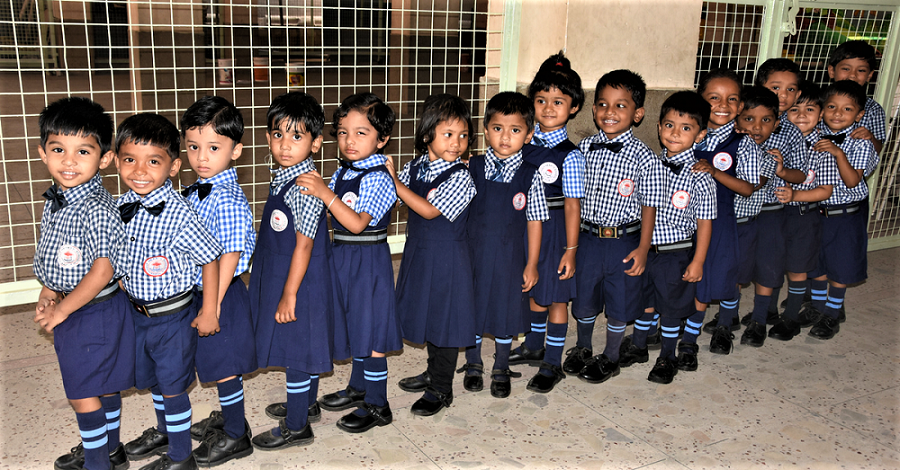Four-year-old Lokesh is the son of a blind father who has a government allowance of Rs.350 a month. Ayush’s father, a cobbler, wishes his fate doesn’t befall on his child. Jhanvi’s mother, a cook, struggles to make ends meet and by no means could she afford the fees of a good school.
More than 5500 children like Lokesh, Ayush and Jhanvi are now going to the most reputed schools of Raipur.

Raipur’s efforts to change the poor implementation of The Right to Education Act (RTE) in the city have helped children from underprivileged families have a fair chance at a good education, which is also free of cost.
The RTE Act reserves 25% of seats in private and government aided schools for children from poor and disadvantaged backgrounds – a fantastic provision that opens the doors for inclusive education.
But as promising as it sounds, the on-ground implementation of this provision has suffered thanks to corruption. When IAS member, OP Choudhury, took charge as the District Collector in Raipur last year, he started evaluating its effectiveness in the capital city.
“We found that many schools were indulging in malpractices to avoid the intake of poor children. They showed fake admissions to avail government grants, claimed they did not receive applications for RTE category, showed favouritism in allotting the reserved seats, and hijacked the seats from the truly deserving.
The recorded data of RTE admissions was completely fudged and we did not know how many children actually got admissions through RTE. The saddest part was that these malpractices compromised the future of many poor children who could otherwise have got a chance at good education. We wanted to change this forever so that the every child gets an equal opportunity at education”, says OP Choudhury.
The District Collector and his team decided that they will use technology to build a truly transparent system for RTE admissions.
The Collector allotted an amount of Rs. 17 lakhs towards this initiative that they called ‘RTE Pardarshi’, meaning ‘transparent’.
A centralized system was developed that would allot seats to the nursery, Kindergarten 1 and Kindergarten 2 classes based on an algorithm and not on human whims and fancies. The online system gave people a clear view of how many seats were available and in which schools. Parents could also apply to multiple schools of their choice for their children.
The District Administration gained tremendous support from volunteer groups that reached out to poor families and also spreading the word were many workshops, school events, and radio and TV programmes.
A dedicated helpline was up to support the queries of the parents. A total of 80 centres helped families in filling the online applications. The team kept the offline applications open too, but surprisingly 90% of the applications for this academic year were submitted online – a testimony to the trust that the online system gained among the poor families.
On an announced date the entire allotment of seats was by the system and announcement of the admissions was made through SMS to the mobile phones of the parents. With the entire process going online, no bogus admissions could be made, no favouritism was possible, no one held discretionary powers on who gets admission and who does not, and 5589 truly deserving poor children got admissions in top tier schools of Raipur.
You may also like: He Didn’t Have a Library in His Town Growing Up. So He Started 20 across India!
Last year, though the records aren’t completely believable owing to the falsifications, an estimated 2800 seats were allotted through RTE. With the new system, the admissions have more than doubled.
Starting this academic year, from the nursery till Class 8, these children will be provided eleven years of education – completely free of cost! This comes in where the annual fees in the private schools in Raipur come up to anywhere between Rs. 30,000 to 1.5 lakh per year.
The government will reimburse the schools for an amount of Rs. 7000 per child every year.
The system, with its centralized database, now has a complete view of RTE admissions across the city and holds the private and aided schools accountable for the RTE admissions. This is a complete shift from the manual admission process that was marred by malpractices.
To sustain the robustness of RTE implementation, a tracking mechanism will also be introduced to monitor the attendance and progress of the children. Realising that adapting to new environments would not be a cakewalk for the children, the District administration is also seeking the help of volunteers to provide special community-based tuitions.
These tuitions will also be offered to government school children. Raipur is also working towards improving the quality of education in government schools by converting 100 government schools into smart schools.
You can write to the District Collector of Raipur, OP Choudhury, at opcias@gmail.com
Like this story? Or have something to share? Write to us: contact@thebetterindia.com, or connect with us on Facebook and Twitter.
NEW: Click here to get positive news on Whatsapp!
If you found our stories insightful, informative, or even just enjoyable, we invite you to consider making a voluntary payment to support the work we do at The Better India. Your contribution helps us continue producing quality content that educates, inspires, and drives positive change.
Choose one of the payment options below for your contribution-
By paying for the stories you value, you directly contribute to sustaining our efforts focused on making a difference in the world. Together, let's ensure that impactful stories continue to be told and shared, enriching lives and communities alike.
Thank you for your support. Here are some frequently asked questions you might find helpful to know why you are contributing?
